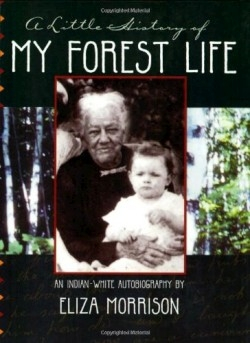A Little History of My Forest Life
An Indian-White Autobiography
In 1894 an old woman sat down to write, at the urging of a Dr.Gray and his wife, whose family she had supplied with bushels of moccasins and meals. She produced what has been called one of the “most remarkable autobiographies created by a woman in the nineteenth century.”
The author was born in 1837 on Madeline Island, the largest of the twenty-two islands that compose the Apostle Group. Covering nearly 600 square miles of southwestern Lake Superior, the area is both remote and brutal in winter. The village of Morrison’s birth, La Pointe, had been a thriving fur company headquarters since the late 1600s. By the beginning of the 1800s, however, it was in decline. Though the fur trade was no longer vigorous, Morrison was a member of its legacy-part Anishnabe, part French, and part Scottish. She grew up in a world where Ojibwa, French, and English were all spoken and mixed bloods were common and accepted.
This book is about transforming social and political climates, as well as a report of a land in metamorphosis, as wilderness gave way to domesticated farmland and reservations. Morrison describes the increasing racial tension as English-speaking populations crowded in.
Seasonal patterns, philosophy, and family history weave together to form a highly unusual and intriguing opportunity to walk in this woman’s moccasins. She describes sugaring in great historic detail: “We used snowshoes the whole time. In three days time we tapped 900 [birch] Bark Buckets.” Morrison’s family “made about one thousands pounds of sugar worth twelve cents a pound?” during two months in the sugar bush.
In addition to the grueling task of preparing and presenting an ancient and fragmented manuscript, editor Brehm provides the reader with informational inserts concerning important and historically pertinent events. Photographs complement the text. An interpretive chapter at the end of the book defines Morrison’s place in the changing region so influenced and formed by the fur trade and its European representatives.
Every so often in life, a window into the past happens to open wide; occasionally someone is there to take a good long look. Morrison’s Little History is such a window. Thanks to Brehm, who took on the challenge of recovering and piecing together the documents, letters, and articles that form this book, we can all look back.
Reviewed by
Gabrielle Shaw
Disclosure: This article is not an endorsement, but a review. The publisher of this book provided free copies of the book to have their book reviewed by a professional reviewer. No fee was paid by the publisher for this review. Foreword Reviews only recommends books that we love. Foreword Magazine, Inc. is disclosing this in accordance with the Federal Trade Commission’s 16 CFR, Part 255.

